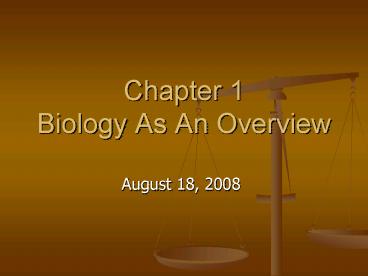Chapter 1 Biology As An Overview - PowerPoint PPT Presentation
1 / 28
Title:
Chapter 1 Biology As An Overview
Description:
Describe the unifying themes that characterize the biological sciences. ... Reproduction (biogenesis) Growth and development (directions stored in heritable DNA) ... – PowerPoint PPT presentation
Number of Views:43
Avg rating:3.0/5.0
Title: Chapter 1 Biology As An Overview
1
Chapter 1Biology As An Overview
- August 18, 2008
2
Objectives
- Exploring Life on its Many Levels
- Describe the unifying themes that characterize
the biological sciences. - Diagram the hierarchy of biological organization.
- Distinguish btwn prokaryotic and eukaryotic
cells. - Describe the basic structure and function of DNA.
- Explain the importance of regulatory mechanisms
in living things. Distinguish between positive
and negative feedback. - Evolution, Unity, and Diversity
- Explain the phrase lifes dual nature of unity
and diversity. - Describe the observations and inferences that led
Charles Darwin to his theory of evolution by
natural selection - Explain why diagrams of evolutionary
relationships have a treelike form
3
Biology Is An Enormous Scope
- Size scales from submicroscopic molecules to
global distribution of biological communities - It encompasses life over huge spans of time, from
contemporary organisms to ancestral life
4
Biology Is An Ongoing Process
- New research methods have led to an information
explosion - Recombinant DNA Techniques
- Technological advances yield new information that
make the conceptual framework accepted by most
biologists - Sequencing of the human genome
5
Unifying themes
6
A. Life is organized on many structural levels
- Atoms, complex biological molecules, sub-cellular
organelles, cells, tissues, organs, organ
systems, complex organism, population, community,
ecosystem, biomes, biosphere
7
B. Each level of organization has emergent
properties
- Emergent property Property that emerges as a
result of interaction between components - Order
- Reproduction (biogenesis)
- Growth and development (directions stored in
heritable DNA) - Energy utilization
- Response to environment
- Homeostasis
- Evolutionary adaptation
8
(No Transcript)
9
Each level of organization has emergent
properties cont.
- Holism The principle that a high level of order
cannot be meaningfully explained by examining
component parts in isolation - An organism is a living whole greater than the
sum of its parts (a cell dismantled into its
chemical parts is no longer a cell) - Reductionism The principle that a complex system
can be understood by studying its molecular
structure - Study genetics through first studying the
structure and function DNA
10
C. Cellular basis of life
- Basic unit of structure and function of life
- Lowest level of structure capable of life
performing all life activities - All organisms are composed of cells
- Unicellular/Multicellular
- Robert Hooke described cells in cork
- Anton Van Leeuwenhoek (1600s) used a microscope
to view microorganisms, blood cells, and animal
sperm - Schleiden and Schwann included all things are
made of cells basis of cell theory
11
Cellular basis of life cont.
- Prokaryotic cells
- Lack membrane bound organelles
- Kingdom Monera
- Smaller than eukaryotic
- Most have tough external walls
- Bacteria
12
(No Transcript)
13
Cellular basis of life cont.
- Eukaryotic Cells
- Membrane enclosed nucleus and organelles,
cytoplasm, some have cell walls - Protists, plants, fungi, animals
14
D. DNA and heritable information
- Biological instructions for an organisms complex
structure and function are encoded in DNA - Inheritance is based on passing information
encoded on DNA from parent to offspring - All forms of life use essentially the same
genetic code. Differences result from different
nucleotide sequences
15
E. Structure/Function Form fits function
- Example The nucleus of a cell
- Membrane to protect DNA
- Nuclear pores to allow mRNA to go to ribosomes
for translation - Example The bones in a hand
- Smaller sized bones allow for delicate and
precise movement
16
F. Organisms interact with environments
- Nutrient cycling
- Energy flow
- Food webs
- Energy conversion
- Chemical energy ? heat
17
G. Unity/diversity
- Taxonomy Science of naming and classifying
organisms (kingdom, phylum, class, order, family,
genus, species) - Five kingdoms Monera, Protista, Plantae, Fungi,
Animalia - Unity is evident in universal genetic code,
biochemical pathways, similarities of cellular
structure
18
(No Transcript)
19
H. Evolution
- Life evolves
- Similar species share a common ancestry
- Darwin natural selection
- variation
- overproduction
- individuals with traits best suited to
environment experience greater reproductive
success
20
(No Transcript)
21
Scientific method
22
Objectives
- Distinguish between discovery science and
hypothesis-based science. Explain why both types
of exploration contribute to our understanding of
nature. - Distinguish between quantitative and qualitative
data and inductive and deductive reasoning. - Describe what is meant by a controlled
experiment. - Distinguish between the everyday meaning of the
term theory and its meaning to scientists. - Explain how science is influenced by social and
cultural factors. Distinguish between science and
technology.
23
- Hypothesis Educated guess proposed as a
tentative answer to a specific question or problem
24
- Inductive Reasoning Making an inference from a
set of specific observations to reach a general
conclusion (cell theory) - Deductive Reasoning Making an inference from
general premises to specific consequences which
logically follow the premises are true - Ifthen logic
- Usually involves predicting experimental results
that are expected if the hypothesis is true
25
- Control Group all variables are held constant
and provides a basis of comparison
26
- Variable condition of an experiment that is
subject to change and may influence the
experiments outcome
27
- Experimental Group The group in which one factor
treatment is varied
28
(No Transcript)

